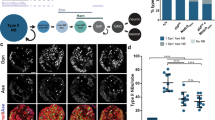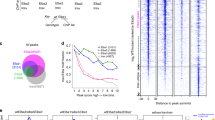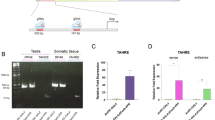Abstract
THE interactions between enhancers and promoter elements that control gene expression are generally considered to act in cis only, but genetic studies suggest that they can also function in trans between non-contiguous DNA molecules. Termed transvection1, such trans interactions have been proposed to be responsible for several examples of intragenic complementation in Drosophila1–9. Transvection is thought to depend on the physical proximity of sister chromosomes10,11, because it is inhibited when chromosome rearrangements reduce the pairing of homologues1,3,5. This led to the suggestion that transvection occurs when enhancer elements on one chromosome regulate expression on the other7,12, with the pairing dependence resulting from a need for proximity between the two copies of the gene. Here we have analysed the levels of transcription from both alleles of the Drosophila Ultra-bithorax (Ubx) gene, and report that the predictions of this simple model are not supported. Our findings indicate a more complex level of trans regulation that may have implications for the aetiology of genetic disorders that are influenced by chromosome rearrangements.
This is a preview of subscription content, access via your institution
Access options
Subscribe to this journal
Receive 51 print issues and online access
$199.00 per year
only $3.90 per issue
Buy this article
- Purchase on Springer Link
- Instant access to full article PDF
Prices may be subject to local taxes which are calculated during checkout
Similar content being viewed by others
References
Lewis, E. B. Am. Nat. 88, 225–239 (1954).
Kornher, J. S. & Brutlag, D. Cell 44, 879–883 (1986).
Gelbart, W. M. Proc. natn. Acad. Sci. U.S.A. 79, 2636–2640 (1982).
Babu, P. & Bhat, S. in Developmental and Neurobiology of Drosophila (eds Siddiqi, O., Babu, P., Hall, L. & Hall, J.) 35–40 (Plenum, New York, 1980).
Jack, J. W. & Judd, B. H. Proc. natn. Acad. Sci. U.S.A. 76, 1368–1372 (1979).
Ashburner, M. Nature 214, 1159–1160 (1967).
Geyer, P., Green, M. M. & Corces, V. G. EMBO J. 9, 2247–2256 (1990).
Dreesen, T. D., Henikoff, S. & Loughney, K. Genes Dev. 5, 331–340 (1991).
Leiserson, W. M., Bonini, N. M. & Benzer, S. Genetics 138, 1171–1179 (1994).
Judd, B. H. Cell 53, 841–843 (1988).
Tartoff, K. D. & Hennikoff, S. Cell 65, 201–203 (1991).
Muller, H. P. & Schaffner, W. Trends Genet. 6, 300–304 (1990).
Lewis, E. Nature 276, 565–570 (1978).
Goldsborough, A. S. & Kornberg, T. B. Proc. natn. Acad. Sci. U.S.A. 91, 12696–12700 (1994).
White, R. H. & Wilcox, M. Nature 318, 567–569 (1985).
Gelbart, W. M. & Wu, C.-T. Genetics 102, 179–189 (1982).
Zachar, Z., Chapman, C. H. & Bingham, P. M. Cold Spring Harb. Symp. quant. Biol. 50, 337–346 (1985).
Castelli-Gair, J. E., Micol, J.-L. & García-Bellido, A. Genetics 126, 177–184 (1990).
Author information
Authors and Affiliations
Rights and permissions
About this article
Cite this article
Goldsborough, A., Kornberg, T. Reduction of transcription by homologue asynapsis in Drosophila imaginal discs. Nature 381, 807–810 (1996). https://doi.org/10.1038/381807a0
Received:
Accepted:
Issue Date:
DOI: https://doi.org/10.1038/381807a0
This article is cited by
-
Benzoic acid treated Drosophila melanogaster: the genetic disruption of larval brain stem cells and non-neural cells during metamorphosis
Toxicology and Environmental Health Sciences (2021)
-
The three-dimensional genome organization of Drosophila melanogaster through data integration
Genome Biology (2017)
-
Involvement of transcriptional enhancers in the regulation of developmental expression ofyellow gene
Science in China Series C: Life Sciences (2001)
Comments
By submitting a comment you agree to abide by our Terms and Community Guidelines. If you find something abusive or that does not comply with our terms or guidelines please flag it as inappropriate.



